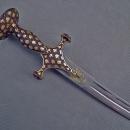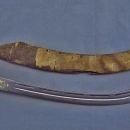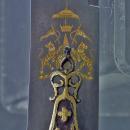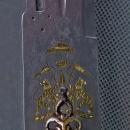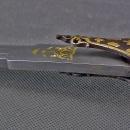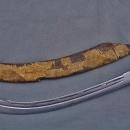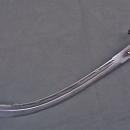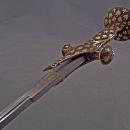Antique Islamic Indian Royal Sword Talwar Tulwar Of The King Ghazi-Ud-Din Haidar Shah the Nawab of Oudh Awadh India








$40,000.00
Or Best OfferA very important Royal Islamic Indian personal short sword, Talwar - Tulwar, owned by King Ghazi-ud-Din Haidar Shah (1769-1827), the Nawab of Oudh (Awadh), early 19th century (circa 1818).
Link to Wikipedia: https://en.wikipedia.org/wiki/Ghazi-ud-Din_Haidar_Shah
The right side of the blade is decorated with an intricate and exquisite gold inlay at the base, depicting the Royal Emblem of The Ghazi-ud-Din Haidar Shah, the Nawab of Oudh (Awadh). The elaborate emblem is composed of a royal parasol (chhatri), a six-pointed star- Seal of Solomon – Khātim Sulaymāni خاتم_سليمانsix- surrounded by two twin fishes (Matsya), and beneath is an Indian dagger Katar surmounted by a Royal crown of Oudh.
There are two tigers rampant regardant as supporters, each carrying a banner adorned with fish. The crest rests on a ribbon with engraved scrolls.
The royal parasol (chhatri) is an ancient symbol of the dome of heaven and was long used in the Middle East and India as a symbol of royal authority. A parasol mark on a blade thus signifies royal provenance and implies that the weapon belonged to a divinely appointed and protected monarch, in this case, Mohammed Wajed 'Ali Shah. This emblem was reserved only for the monarchs and forbidden to use by anyone other than the king.
The back of the blade's spine, below the crossguard, is gold inlaid in Arabic calligraphy with the number 33, possibly a magical talismanic number.
Many Islamic swords, including Indo-Persian swords bearing various talismanic numbers, are believed to be imbued with magical properties and intended to guide, empower, and protect the owner from danger, evil, harm, and sickness. These talismans were meant to empower; they also denoted a sense of vulnerability and a fear of danger and the unknown.
DETAILS: superbly hand forged from welded mechanical Damascus steel, this broad and sturdy single-edged blade has a pronounced false edge yelmen. It is cut on each face with a series of unusual fullers, including a full–length central fuller and five short fullers along the back edge interrupted by three punched dots.
The blade's spine is near the hilt, and the yelmen is raised, which is characteristic of 17th-century Indian blades made in the style of European blades made by Genoese and Styrian swordsmiths. Those blades were imported to India during the late 16th -early 17th century and are known in Mughal India by the name Firangi.
The name Firangi was given to all sword blades of European origin imported into India during the 16th and 17th Centuries. These blades were highly valued in the Mughal empire, so the Indian swordsmiths started making them on European patterns and stamped them with pseudo-European makers' marks. Some were made of Damascus steel with a watered pattern like this blade.
Some Indian blades were made of welded mechanical Damascus steel with a watered pattern like this blade.
So, possibly, the sword's blade was made in the 17th century in a workshop supplying the Mughal court, and the gold-inlaid royal emblem of Mohammed Wajed Ali Shah, the Nawab of Oudh (Awadh), was added later in the 19th century during his reign.
The Mughal emperor Aurangzeb's sword talwar, in the collection of The Metropolitan Museum of Art in New York, has a similar blade (manufactured around 1600 AD) with a raised spine of the blade near the hilt and the Yelmen and cut on each face with a series of different length narrow fullers.
Please see the link below.
https://www.metmuseum.org/art/collection/search/24328
Since the high-quality older blades made of hand-forged welded mechanical Damascus steel were precious in the Islamic world and would not go out of fashion or style, they were part of the heirlooms passed down from generation to generation. Many of these older blades were adorned over centuries with the new owner's name or the coat of arms and remounted with the new hilt.
The blade is mounted with a steel hilt of characteristic northern Indian style formed of bellied grip that runs down to a pair of integral quillons with swollen terminals and long shaped langets, extending down the sides, with a large prominent disk-shaped pommel (Katori) with a flower (phool). The top is surmounted by a bud-shaped finial pierced in the middle with a small hole to thread a silk suspension string through, which is wrapped around the wrist to prevent loss in combat.
The hilt is adorned with a distinguishing Mughal floral pattern thickly overlaid with gold on a deeply hand-chiseled, punched, browned background.
The sword is accompanied by its original wooden scabbard, covered in silk fabric. Please see the last four pictures in the listing.
Due to the high carbon content, the blade is weighty but very well-balanced. Its slightly curved blade is superbly designed to transfer the force of impact to the wider end of the blade (yelmen). The sword has a very sharp cutting edge, which makes it an excellent chopper.
Since the hilt is similar in size to other Indian tulwars, this talwar was possibly made for an adult man, and the short blade was designed for close combat as a secondary sword.
The Nawabs of Oudh were the hereditary Muslim rulers of the Hindustani state of Oudh, of which Lucknow was their capital during the 18th-19th century; at first as a Mughal province, then after The East India Company (EIC) influence as the kings of Oudh (Awadh).
MEASUREMENTS:
The sword's overall length, including the hilt: 62 cm (24.41 inches).
The overall length of the blade: 50 cm (19.61 inches).
Width of the blade at the Yelmen: 33 cm (1.26 inches).
The thickness of the blade spine: 6 mm (0.35 inches).
Weight of the sword without the scabbard: 695 grams (1.529 lb.).
CONDITION: The sword has signs of aging and usage, as the steel blade has slight pitting and the sharp cutting edge has some combat nicks. Please note that the pictures in the listing are part of the object's description and condition. The characteristic Indian Damascus watered pattern lamination in the steel forge layered structure can be slightly seen in several places on the blade. The scabbard is damaged, and the silk fabric is worn out.
REFERENCES:
1. To see a similar Royal Emblem on the gold medal of Nawab Ghazi-ud-din Haidar of Awadh and more information regarding the Awadh, please see the link below.
http://www.hubert-herald.nl/BhaAwadh.htm#HerAO
2. A sword from the early 19th century in the Royal Armouries Museum collection in the UK, gold inlaid with the same Royal Emblem of The Ghazi-ud-Din Haidar Shah, the Nawab of Oudh (Awadh).
Please see the link below:
https://royalarmouries.org/collection/object/object-1760
It is also published on page 81 of the book "Indian Arms And Armour" by Thom Richardson and Natasha Bennet.
If you want to know more about Ghazi-ud-Din Haidar Shah, please refer to the link below.
https://en.wikipedia.org/wiki/Ghazi-ud-Din_Haidar_Shah
3. "On Damascus Steel" by Leo S. Figiel.
PROVENANCE: Ex-private old Canadian collection of Islamic art, including Muslim arms and armor, formed in the 1980s.
We will also provide the buyer with photocopies of the references' pages and a certificate of authenticity.
